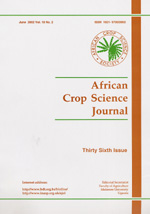
|
African Crop Science Journal
African Crop Science Society
ISSN: 1021-9730
EISSN: 1021-9730
Vol. 9, No. 1, 2001, pp. 245-250
|
 Bioline Code: cs01054
Bioline Code: cs01054
Full paper language: English
Document type: Research Article
Document available free of charge
|
|
|
African Crop Science Journal, Vol. 9, No. 1, 2001, pp. 245-250
| en |
Efficacy And Economics Of Fungicide Spray In The Control Of Late Blight Of Potato In Ethiopia
Kassa, Bekele & Beyene, Hailu
Abstract
During the 1996 and 1997 seasons research was done at Holetta on the economic
benefits of integrated management of late blight using genetic resistance and
chemical (preventive and /or contact) methods. Varieties Tolcha (tolerant to
late blight) and AL-624 (susceptible to late blight) were studied with five
chemical controls during crop development. The chemical control started immediately
after the first disease symptom was observed (41 days after crop emergence) and
chemical control was repeated after every 7 days for contact fungicides and
21 days for preventive fungicide. In 1997 AL-624 and Tolcha received 4 -5 and
2 applications, respectively, of the protectant fungicide whereas the preventive
fungicide was applied 3 and 2 times on the susceptible and tolerant variety,
respectively. In 1996 all contact fungicides were applied 5 times and the preventive
fungicide 2 times on AL-624 while on Tolcha it was applied 3 and 1 time, respectively.
Results showed that the use of preventive fungicide like Ridomil MZ 63.5% WP
and contact fungicide such as Brestan 10, Chlorothalonil and Dithane M-45 can
earn potato producers above the acceptable level (100%) of marginal rate of
return (MRR). Thus, both genetic resistance and chemical control provide economic
options for management of late blight.
Keywords
Economic benefit, fungicides, genetic resistance, Phytophthora infestans, Solanum tuberosum
|
| |
| fr |
Kassa, Bekele & Beyene, Hailu
Résumé
Pendant les saisons 1996 et 1997, une recherche a été conduite
à Holetta sur les bénéfices économiques de la gestion
integrée du mildiou en utilisant une résistance génétique
et des contrôles chimiques (préventif et/ou de contact). Les variétés
Tolcha (tolérante au mildiou) et AL-624 (sensible au mildiou) ont été
étudiées avec cinq traitements chimiques pendant le développement
de la culture. Le contrôle chimique a commnencé immédiatement
dès que l' apparition des symptômes de la maladie a été
observée (41 jours après émergence) et il a été
répété après chaque 7 jours pour le fongicide de
contact et 21 jours pour le fongicide préventif. Les cultivars AL-624
et Tolcha ont reçu en 1997 4-5 et 2 pulvérisations respectivement
du fongicide protectant alors que le fongicide préventif a été
appliqué 3 et 2 fois sur la variété sensible et tolérante
respectivement. En 1996 tous les fongicides de contact ont été
appliqués cinq fois et le préventif 2 fois sur AL-624 alors qu'il
a été appliqué 3 et 1 fois respectivement. Les résultats
ont montré que l' utilisation du fongicide préventif tel Rodomyl
MZ 63.5% WP et le fongicide de contact tel que Brestan 10, Chlorothalonil ET
Dithane M-45, les producteurs peuvent gagner au dèla du niveau acceptable
(100%) du taux marginal du revenu (MMR). Ainsi, la résistance génétique
et le contrôle chimique fournissent des options de gestion de contrôle
du mildiou.
Mots Clés
Bénéfice économique, fongicides, résistance génétique, Phytophythora infestans, Solanum tuberosum
|
| |
© Copyright 2001 - African Crop Science Society
|
|
